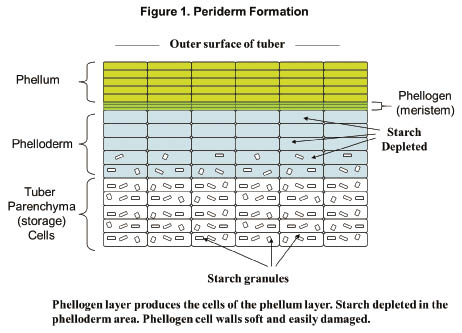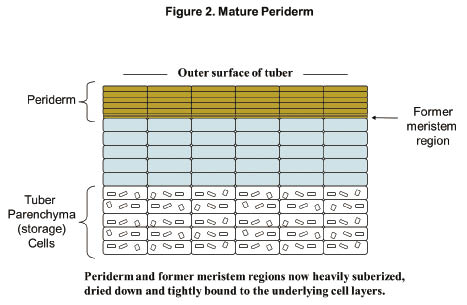
As we get into the final stages of growing a potato crop, a number of season-ending activities come to mind. Things like vine kill and skin set. We all know that skin set is important, but what exactly is this process and what can we do to ensure that it occurs properly and in a timely fashion?
In spite of its below-ground growth habit, the potato tuber is a stem, not a root, and, as such, has a number of features that are associated with stems. With this in mind, the "skin" or periderm of the potato tuber very much resembles the bark on the stem (trunk) of a tree. Like the bark of a tree, the periderm is a tough coating that protects from moisture loss and from invasion by diseases, insects and other pests.
When you think about it, the periderm of a potato tuber has an extremely difficult job to do. It must somehow provide protection and continue to do so during the entire tuber bulking process-a process characterized by dramatic increases in tuber size on a daily basis. You might look at the process of periderm formation as a race between the expanding tuber and the continuing development of the periderm coat to keep the ever-increasing surface area of the tuber covered and protected.
To accomplish this challenging task, the periderm must be in a state of constant growth until the tuber itself stops growing. A by-product of this requirement for constant growth is that the periderm is not tightly bound to the underlying tissues, so it is very easy to "slip" the skin off an immature tuber. The slippage occurs in a specific region of the immature periderm, which we will discuss in a moment, but first let's take a more in-depth look at the process of periderm formation.
Figure 1 represents a cross sectional view of developing periderm. There are three important zones in this diagram. The green zone is a meristematic region called the "phellogen." The tissues within a plant where rapid cell division is taking place are called "meristems."
Outward of the phellogen are five to six tiers of "phellum" cells (the yellow zone) that were produced by the phellogen meristem. The structure of the phellum layer is sometimes described as resembling a "brick wall," because it consists of a series of flattened, brick-shaped cells stacked on top of one another. Unlike a brick wall, the cell layers are not offset like alternating courses of bricks would be.
Inward from the phellogen is the "phelloderm" region, which provides the energy and biochemical building materials for the growth process. The cells in the phelloderm region generally lack starch granules because the granules have been sacrificed to provide the energy needed for periderm formation.
When the skin on an immature tuber "slips" due to mechanical pressure, it is because the walls of the cells in the phellogen meristem (green) area are very soft and easily damaged. The same characteristic that allows the periderm to continue expanding like an inflating balloon as the tuber grows also makes the periderm very vulnerable to slip damage.
When the tuber finally stops growing, due to vine death and/or other factors, the skin set process is initiated. The meristem stops producing new cells, the cell walls harden off, and everything from the former meristem area to the outside (the entire phellum region) becomes heavily suberized. During this process, the periderm becomes tightly bound to the underlying tissues and is then very resistant to mechanical damage (Figure 2). Like the bark of a tree, the now mature phellum cells are no longer alive.
So now that we know how skin set occurs, what can be done to promote it? The major factors that contribute to final skin set include variety, soil type, cultural and environmental conditions, vine maturity and duration from vine kill to harvest. Varieties differ in their rate of skin set. This is primarily a function of genetics but also late season bulking rates and how the variety responds to the conditions in the field. Smooth-skinned varieties, such as a red potato, do not set a skin as rapidly as Russet Burbank.
Since the tuber needs to essentially be no longer bulking or expanding for skin set to begin, it is best to avoid real green vines into the later part of the season. Nitrogen should not be applied past the middle of August in Idaho in order to promote a healthy skin set. Vines should be dead for 10-21 days prior to harvest depending upon vine maturity or "greenness" at the time of vine kill and variety. But beware, the longer potatoes sit in the ground after vine kill, the greater the risk for black scurf (Rhizoctonia) and silver scurf development. Some varieties, such as Ranger Russet, store well even with a limited duration from vine kill.
Soil conditions, both temperature and moisture, can influence periderm maturation. Available soil moisture should be managed for 60-65 percent at vine kill to promote skin set. Cool and wet soil conditions can delay maturation, whereas warmer soil temperatures increase the number of cell layers and thickness of the periderm. Warmer soil temperatures are often not a luxury late into the harvest season.
Proper skin set needs to be in balance with desired yield, weather and market end-use of the potato. Proper skin set for stored potatoes is very important when you consider an immature potato has 10 to 60 times greater weight loss compared to a mature potato. The implications for weight loss, bruise potential and disease susceptibility need to be carefully considered when managing for skin set.

